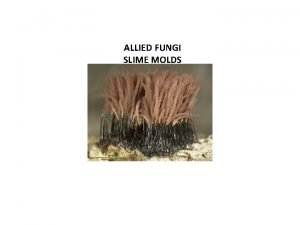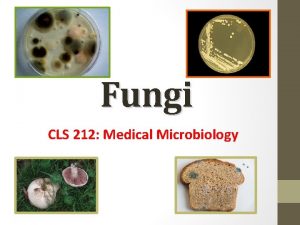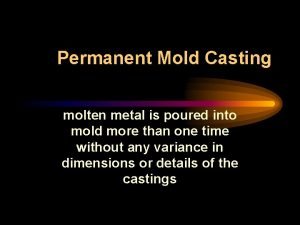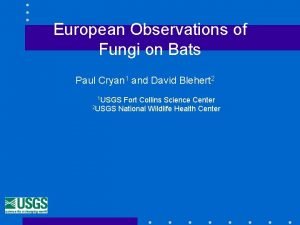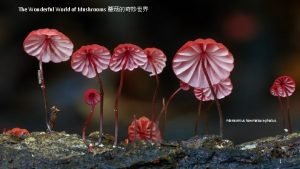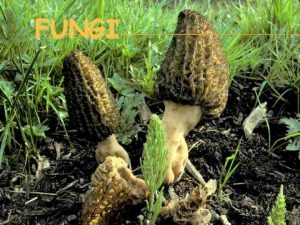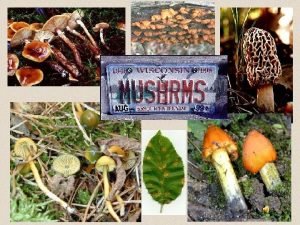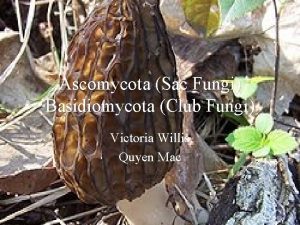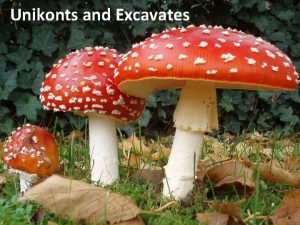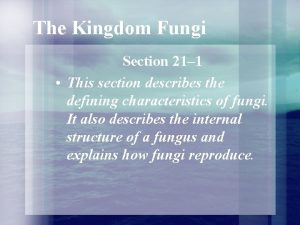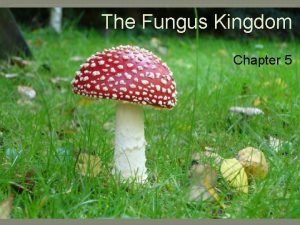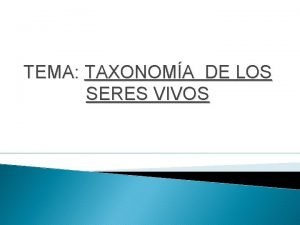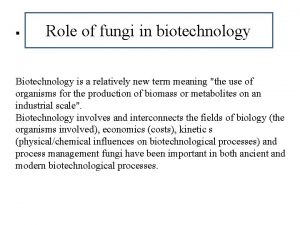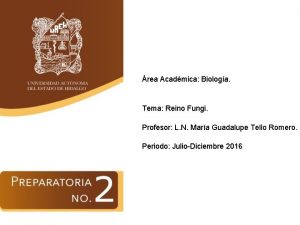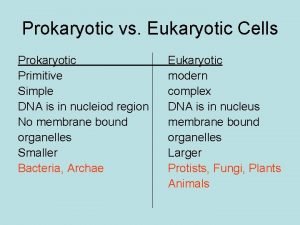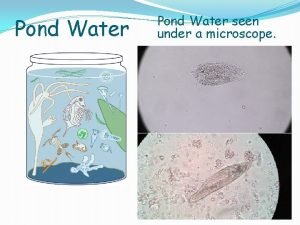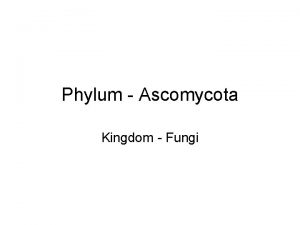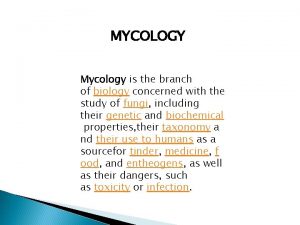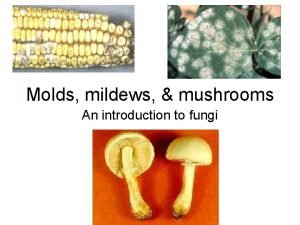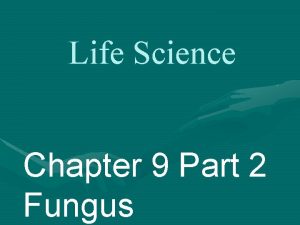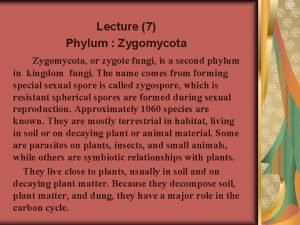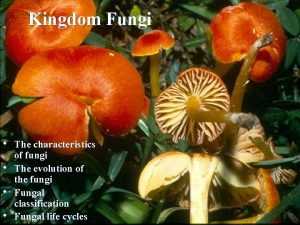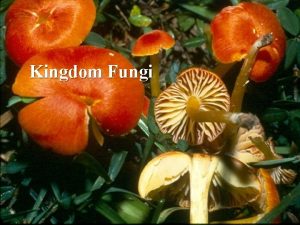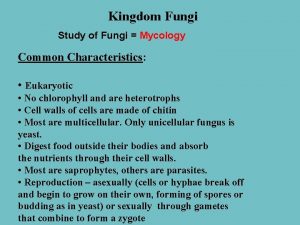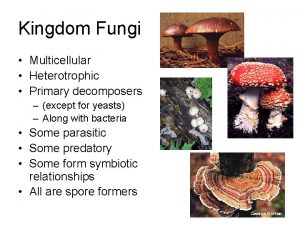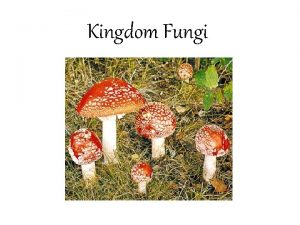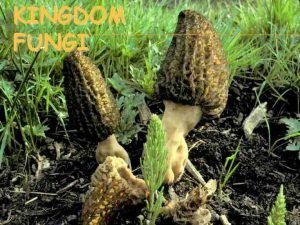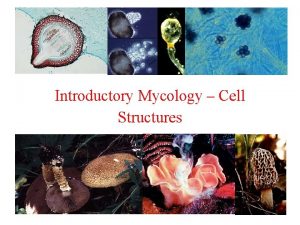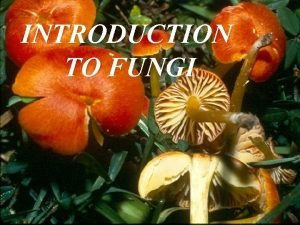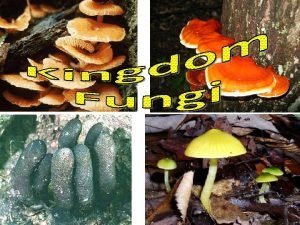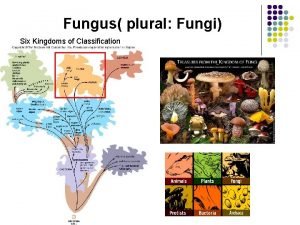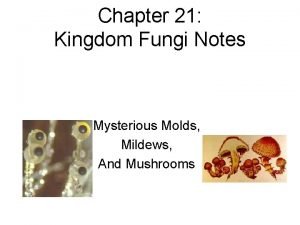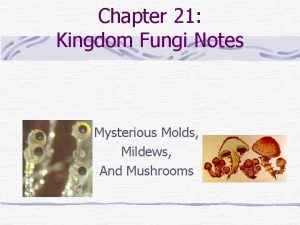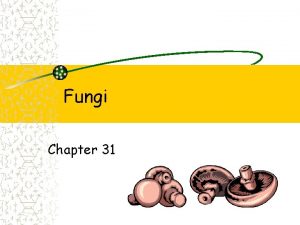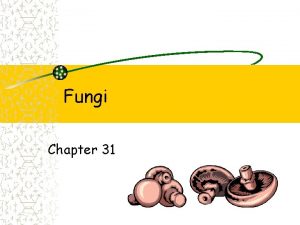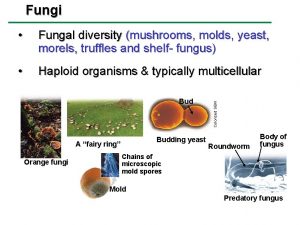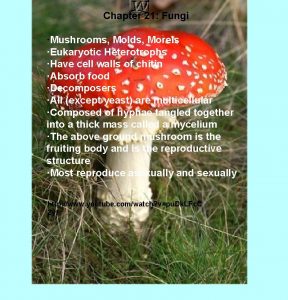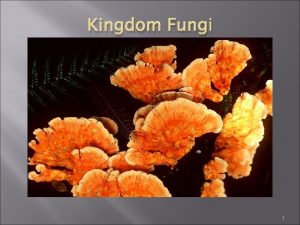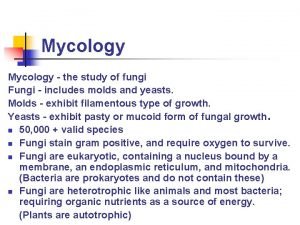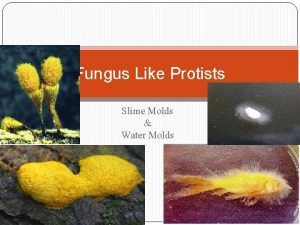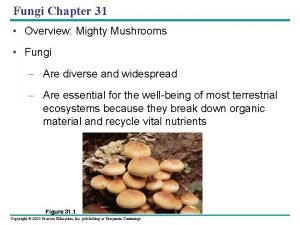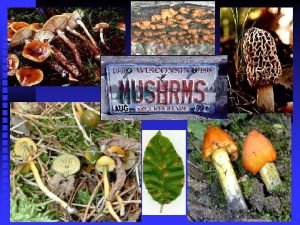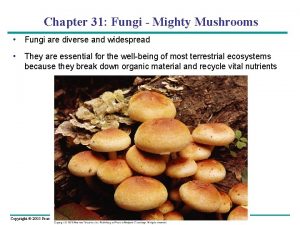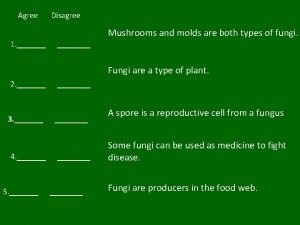Molds mildews mushrooms An introduction to fungi Fungi

























































- Slides: 57

Molds, mildews, & mushrooms An introduction to fungi

Fungi • Significant group of organisms – both basic and applied biology • Large Kingdom – – 80, 000 -120, 000 species described – Estimated to be 1. 5 million species • We will briefly survey the fungi and related organisms

Roles of fungi • • Pathogens of plants and animals Symbionts with plants and animals Decomposers of organic matter Deterioration of substances – wood, paper, grain, foods Food and food products Toxins and allergens Myths & Religions Tools in biology

Plant pathogens • Fungi are major pathogens of plants – cause great deal of damage to crops Example: Wheat rust • Major losses in yields of wheat • Romans had a god of rust Robigus • In Southeastern US – Wheat rust severe, can’t grow wheat – Corn replaced wheat • cornbread, bourbon

Coffee rust epidemic in Ceylon

Irish potato famine • Potato imported to Europe in 1500’s, became a staple • Several years of favorable weather lead to epidemic of late blight of potatoes • Caused the Irish potato famine – mid 1800’s

Late blight of potato • Caused by Phytophthora infestans • No longer considered a true fungus

Fungal diseases of animals & humans • Generally less widespread than diseases caused by bacteria and viruses (exception – athletes foot), but can be severe • Certain diseases endemic to geographic areas – e. g. valley fever caused by Coccidioides sp. in the desert SW • Incidence of human mycoses is on the increase with use of immunosuppresant drugs and AIDS

Fungi as symbionts • Mycorrhizal association is very common among plants • Lichens

Fungi as decomposers • Important agents in the flow of energy and cycling of nutrients in biosphere • Decomposition particularly of plant litter • Food for higher trophic levels

Fungi as agents of deterioration • Cause deterioration of organics –food, wood, clothing, leather • Variety of antifungal products developed

Food and food supplements • Yeast – bread and alcohol • Mushrooms • Fermentation of plant products (soybeans) – soya sauce, tempeh, miso tofu, etc.

Mycotoxins • Produced by microfungal species on different stored food products • Aflatoxin produced by Aspergillus flavus

Allergens • Spores present in outdoor & indoor air • Sick building syndrome • Stachybotrys

Myths & Religions • Hallucigenic mushrooms

Used as model systems in biology • Neurospora crassa – 1 gene – 1 enzyme • Saccharomyces • Aspergillus

Major characteristics of fungi • • Eukaryotic Heterotrophic Osmotrophs Modular organisms – indeterminate growth Multinucleate Generally surrounded by cell wall Generally nonmotile (some produce motile cells) Most form spores as reproductive units

Fungal biology • Fungal body = thallus • Vegetative (somatic) phase – absorbs and assimilates nutrients, grows • Reproductive phase - all or part of thallus may differentiate to form reproductive structures – spores • Asexual (mitosis) or sexual reproduction (meiosis, fertilization)

Vegetative thallus • Variable – but most fungi form a branching network of multinucleate filaments • Filament = hypha (pl. hyphae) • Exceptions – yeasts, some lower fungi

Mycelium = filamentous fungal thallus • All hyphae in a thallus form the mycelium

Largest mycelia • Armillaria bulbosa – fungus humongous • 30 acres, 10 tons, 1500 years old

Hyphae • • Walled tubes that contain cytoplasm Eukaryotic – nuclei, mitochondria, ER, etc Grow at tip Form lateral branches that grow at tip

Basic types of hyphae • Aseptate hyphae – lack crosswalls, found in lower fungi • Septate hyphae – crosswalls divide hyphae into compartments, are incomplete, found in higher fungi

For filamentous fungi • What is a cell? – Not typical with one nucleus controlling a defined volume of cytoplasm, many nuclei occur together – Have age transitions – tip is young with senescent cytoplasm away from the tip • What is an individual? Hyphae from two individuals may fuse • two or more one Hyphal pieces may be separated from thallus • one two or more

Basic structure of hyphae • Size – 2 μ m to 1 mm in diameter, – 5 -10 μm most common • Surrounded by cell wall – gives hypha shape and prevents it from bursting from osmotic pressure – Cell walls composed primarily of polysaccharides with less than 10% proteins and lipids – Microfibrillar polysaccharides embedded in an amorphous matrix

Cell walls • Microfibrillar polysaccharides – in most fungi is chitin – polymer of N-acetyl glucosamine ( 1, 4) • Chitin accounts for 5 -60% of cell wall • Amorphous matrix contains a variety of polysaccharides – glucans, mannans

Fine structure of hyphae • Apical region of hyphal tip – typically 150500 μm long. • Dense cytoplasm, rich in organelles, few vacuoles • Extreme tip (1 -5 μm) contains many small vesicles (the apical vesicle cluster, AVC) – with light microscope = spitzenkörper (in sepatate hyphae only); no other organelles • Behind the apical region, vacuoles increase in number and size, lipid granules accumulate

Fungal hypha

Hyphal tip

Nuclei • Small (1 -2 μm) • Nuclear envelope does not break down during division, chromosomes not distinct • In apical region there are 1 -50 nuclei • Fungal DNA less complex than other eukaryotes - fewer repeated DNA segments compared to other eukaryotes (less than 10% compared to 35% in mammals)

Nuclei

Organelles • Mitochondria – elongate with platelike cristae • Endoplasmic reticulum – narrow membrane bound channels • Golgi – ringed cisternae not flattened stacks

Hyphal growth • Growth occurs at the tip • Grow in pulse of radiolabelled wall precusor • Vesicles also concentrated at tip – few other organelles in tip

Hyphal growth • Not the same as cellular growth • Filamentous fungi do not undergo cell division after cell has doubled in size • Duplication cycle (analogous to cell cycle) • Apical compartment grows to a particular length, nuclear division followed by formation of 1 to several septa

Hyphal branching

Hyphal branching

Carbon nutrition of fungi • All fungi are heterotrophic – obtain C from organic sources • In this regard, they are like animals, but • Absorb nutrients from environment, do not ingest food

Three modes of heterotrophy • Saprotrophs (saprophytes)– obtain C from non-living organic matter • Biotrophs – obtain C from living organic matter – Parasites – Symbionts • Necrotrophs – kill organisms and use C of dead bodies – Parasites • Facultative or obligate

Fungi and Plants • Originally fungi were classified with plants – nonmotile, have cell wall • Are also similar to plants in that they are modular organisms not unitary like animals • Modules in plants – buds and branch; in fungi – hyphal tips • Comparison of characteristics of modular with unitary organisms

Unitary vs modular organisms Characteristic Unitary Growth pattern determinate Modular Size Indeterminate, iterative Adults vary little Varies greatly Mobility mobile Acquisition of resources Reproductive capability Use mobility immobile Grow to resources Increases with Can increase age, decreases indefinitely

Unitary vs modular organisms Clonal reproduction Internal age structure Longevity Local damage Unusual Common Absent Present Definite life span Serious Indefinite life span Unimportant

Vegetative phase Reproductive phase • After period of growth, differentiation may occur • Reproduction can be sexual or asexual • Functions of reproduction – Recombination of genetic information – Propagation and dispersal of fungus – Dormancy – dispersal through time

Asexual reproduction • Fragmentation of thallus • Production of asexual spores (two main types) – Sporangiospores – develop within a sporangium • Lower fungi – Conidium (pl. conidia) – formed externally at the tips of specialized hyphae • Higher fungi

Sporangiospores

Conidia

Sexual reproduction • Three events occur in sexual life cycle – Plasmogamy – union of two cytoplasms – Karyogamy – union of two nuclei – Meiosis – reduction division • (In most organisms plasmogamy and karyogamy occur close together – called syngamy or fertilization

Sexual life cycle • The three events lead to three phases based on nuclear condition – Haploid (1 n) – one set of chromosomes per nucleus – Diploid (2 n) – two sets of chromosomes per nucleus – Dikaryotic (n+n) – two sets of genes in separate nuclei • Vegetative phase may be any of the above

Sexual life cycle

Sexual reproduction • Spores are typically produced • May be produced after plasmogamy & karyogamy – diploid (zygospores) • May be produced after meiosis – haploid (meiospores)

Reproductive phases • Fungi may carry out sexual reproduction, asexual reproduction or both types • The sexual reproductive phase is the teleomorph (perfect phase) • The teleomorph is used in phylogenetic classification system • No problem for those species that reproduce sexually or both sexually and asexually – can identify and classify based on teleomorph

Reproductive phases • Asexual reproductive phase = anamorph (imperfect phase) • For those fungi that only produce anamorph, there is a problem – can’t classify in the phylogenetic classification system for fungi • Sometimes difficult to connect anamorph and teleomorph - holomorph • Separate artificial classification scheme set up for anamorphs

Phylogeny of fungi • Traditionally fungi were classified with plants • Theories that fungi evolved from algae • Today, considered that fungi did not evolve from algae and are not very closely related to plants

Evidence for phylogeny of fungi • A number of lines of evidence that fungi are not closely related to plants • Most compelling evidence comes from recent work comparing base sequences of r. DNA and other genes among organisms

Kindom Fungi • Four phyla • Chytridiomycota & Zygomycota – “lower fungi” • Ascomycota & Basidiomycota – “higher fungi”

Fungal phyla – lower fungi • Chytridiomycota • Zygomycota

Fungal phyla – higher fungi • Ascomycota • Basidiomycota

Classification • Endings for major taxa of fungi – -mycota = phylum (division) – -mycotina = subphylum – -mycetes = class – -ales = order – -aceae = family
 Is protista unicellular or multicellular
Is protista unicellular or multicellular Cellular vs plasmodial slime molds
Cellular vs plasmodial slime molds Allied fungi general characteristics
Allied fungi general characteristics Diversity of protists
Diversity of protists Advantages of suppository
Advantages of suppository How to make slip casting molds
How to make slip casting molds Disadvantages of sbm
Disadvantages of sbm Monomorphic fungi
Monomorphic fungi Custom molds inc
Custom molds inc Graphite permanent mold casting
Graphite permanent mold casting Conjugated fungi
Conjugated fungi Fungi autotroph or heterotroph
Fungi autotroph or heterotroph Oh shiitake mushrooms bill
Oh shiitake mushrooms bill Paul cryan
Paul cryan Berserkers mushrooms
Berserkers mushrooms Marasmius haematocephalus
Marasmius haematocephalus Workbook es contable o incontable
Workbook es contable o incontable A lot of countable or uncountable
A lot of countable or uncountable Mushrooms hoax. stop hacks
Mushrooms hoax. stop hacks General characteristics of fungi
General characteristics of fungi Deuteromycetes
Deuteromycetes Sac fungi
Sac fungi Conclusion paragraph format
Conclusion paragraph format Unikonta definition
Unikonta definition Unicellular and multicellular organisms
Unicellular and multicellular organisms Multicellular organism means
Multicellular organism means Section 21-1 the kingdom fungi
Section 21-1 the kingdom fungi Sac fungi
Sac fungi Ejemplos del reino vegetal
Ejemplos del reino vegetal Commensalism relationship example
Commensalism relationship example Role of fungi in biotechnology
Role of fungi in biotechnology Estrutura celular de um fungo
Estrutura celular de um fungo Reino monera características
Reino monera características Amoeba prokaryotic or eukaryotic
Amoeba prokaryotic or eukaryotic Organism examples
Organism examples Archaebacteria eubacteria protista fungi plantae animalia
Archaebacteria eubacteria protista fungi plantae animalia Higher fungi
Higher fungi Branch of biology concerned with the study of fungi
Branch of biology concerned with the study of fungi Animalia fungi plantae
Animalia fungi plantae Fungi
Fungi Fungi obtain energy
Fungi obtain energy Fumgus
Fumgus Black bread mold phylum
Black bread mold phylum Similarities between protists and fungi
Similarities between protists and fungi What do kingdom fungi and kingdom plantae share
What do kingdom fungi and kingdom plantae share Fungi characteristics and examples
Fungi characteristics and examples What is hyphae and mycelium
What is hyphae and mycelium Fungal cell characteristics
Fungal cell characteristics Characteristics of the fungi kingdom
Characteristics of the fungi kingdom Multicellular heterotrophs
Multicellular heterotrophs Ascomycots
Ascomycots Fungi obtain energy
Fungi obtain energy Characteristics of yeast
Characteristics of yeast Fungi spore
Fungi spore Planogametic copulation
Planogametic copulation Fungi photosynthesis
Fungi photosynthesis Sexual or asexual reproduction
Sexual or asexual reproduction Mind mapping fungi
Mind mapping fungi


